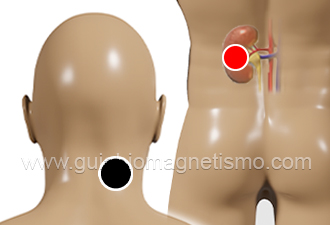Toxins Reservoirs
The organism continuously produces toxic waste that is handled by various disposal systems: such as the circulatory system, kidneys, skin, lymphatic system. In cases of infection or alteration of the tissues, a greater amount of waste substances, produced by the same body cells or pathogens agents, can be produced. This can cause inflammation, which if chronic or acute can develop any of the following anomalies:
Abscess:
The abscess is an accumulation of pus in some body tissue, internal or external, as a result of an infectious process. There are various types of abscesses, for example liver abscess. According to Dr. Goiz, the abscess is due to the accumulation of toxins produced by at least two bacteria. Some examples:
- Intracranial. It is drained by applying magnets in the occipital region.
- Intraspinal. It can be cervical, dorsal, lumbar, sacral or coccygeal
- Mediastinal. To drain thorax and / or upper limbs
- Subdiaphragmatic. Right or left to drain the abdominal cavity
- Inguinal. Right or left to drain lower limbs
Some abscesses can be drained mechanically after treatment with biomagnetism.
Dr. Goiz explains the syndrome of the candle in which the toxins descend by gravity through the back reaching the lumbar vertebrae (L4-L5) where they weaken the structures such as ligaments and discs causing, over time, the herniated disc . Place a negative magnet on the damaged vertebrae and a positive kidney.
Exudate:
It is the accumulation of fluid (toxins) as a result of an infectious process. The exudate is produced, either by the same pathogenic organism, or by overexited body cells due to infection. The exudate can cause inflammation and remain for some time after the infection has been controlled.
Trasudate:
It is the alteration in a cavity, produced by the accumulation of element or substance. Unlike the Infiltrate, the transudate does not obey an infectious process.
Infiltrate:
According to biomagnetism, it is the alteration in a potential cavity, produced by the accumulation of an element or substance that has different protein characteristics. The potential cavities have various functions such as the protection of the organs they contain, damping and avoiding friction, formed by membranes and high protein content; They are as follows:
- skin, presents dermatitis.
- pleura, (contains the lungs) presents pleurisy
- pericardium, (contains the heart) presents pericarditis
- peritoneum, (contains the intestines) presents peritonitis
- periosteum, (contains various bones)
- meninges, (it contains the brain and spinal cord) it presents meningitis or intracranial edema, it is impacted
- joint cavities, (contains various joints), presents inflammation or arthritis
When two or more excited pathogenic viruses are associated, abnormal fluid is produced in the spaces mentioned. If a bacterium is linked to the associated viruses, we can have a septic infiltrate. In allopathy the infiltrate can be acute or chronic, bacterial, leukocyte, tumor, and so on. In Radiology it is presented as a localized or diffuse opacity.
Depending on where they are staying is where the disorder will develop. In this case the virus is inhibited by the impact of the corresponding biomagnetic pairs and the cavity is drained.
Toxin drainage
The infiltrates are drained according to their location by placing the following pairs:
- Head:
occipital region - kidney*
- Intraspinal:
vertebra - kidney
- Thorax and upper limbs:
mediastinum - kidney
- Abdominal region:
subdiaphragmatic - kidney
- Pelvis and lower limbs:
inguinal - kidney

Granuloma:
It is a more or less spherical mass of immune cells that forms when the immune system tries to isolate foreign substances that it has been unable to eliminate. Granulomas indicate a chronic infection caused by the association of fungi and bacteria, it will be necessary to do a thorough scanning to find the causative pathogens.

